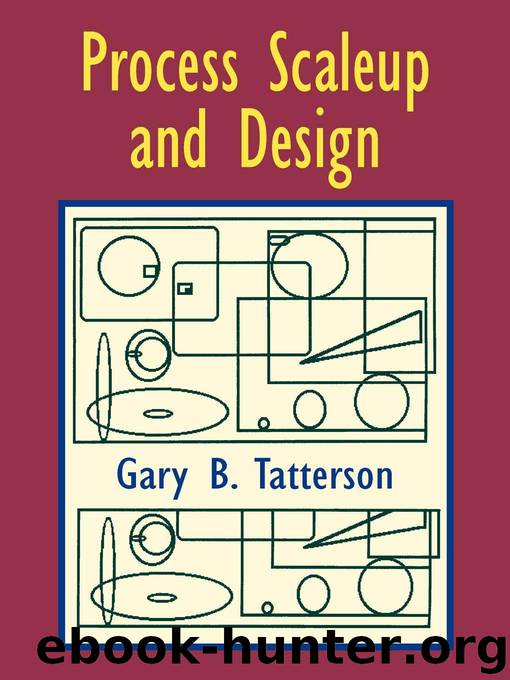Process Scaleup and Design by Tatterson Gary Benjamin Dr

Author:Tatterson, Gary Benjamin, Dr.
Language: eng
Format: azw3
Publisher: Gary Tatterson
Published: 2012-05-07T16:00:00+00:00
Do Not Cause or Generate Needs
It is much easier to prevent the problem from occurring rather than fixing it later in the process.
An example is again the addition of a free-flowing powder to a tank. Lumps are immediately formed. Significant batch time, almost a double in batch time, is added to the procedure to dissolve the lumps. However, if the powder had been added through a sifter, then the lumps would not have formed. Doubling of the batch time would not be needed.
Feeding a filter press using a centrifugal pump or from a holding tank can cause problems if the strength of the crystals being filtered is weak. Pump and holding tanks have rotating impellers that can cause crystal breakage and increases in filtration times due to the presence of fines.
Another example occurs in batch filling operations. Typically, material is added to a tank up to a certain amount by weight from a storage tank. During the addition, the weight of the tank is monitored. In many operations, numerous materials are being added. The problem is that the batch times are very large due to filling. A problem has been made. A need exists to reduce batch times.
As a design alternative if pre-weigh tanks were used, material could be pre-weighed. Multiple additions could be made at the same time. For example, with 20 different additions and five pre-weigh tanks, the number of additions to the main batching tank can be reduced from 20 to 4. This could reduce batching time down by a factor of five. Production could be increased by a factor of five.
Another alternative would be to place the requirement of feed measurement on the supplier by ordering only pre-measured, packaged quantities. This, however, may be expensive.
Engineering Point: Addition times during batching can be reduced significantly. This results in substantial reductions in batching times and significant increases in production.
Engineering Point: Do not use problem processes
This engineering point is actually a restatement of the KIS principle. An example is the synthesis of organic chemicals. Often, at the end of a procedure, statements are included which state: dewater, filter, dry, and reincorporate. If such procedures were scaled, there would be a dewatering process, a filtering process, a drying process and a reincorporating step. Three of those steps, i.e., filter, dry and reincorporate, can be particularly difficult and represent problem processes that are difficult to scale. Hence, these and other similar problem processes should be avoided. A new synthesis route should be chosen for the pilot plant and the plant to avoid these processes all together.
Unfortunately, difficult and/or problem processes may be unavoidable. Returning condensate at or near its boiling point is difficult since pumps have little NPSH under such conditions and are likely to cavitate. Problem processes can also be unpredictable processes, which will be discussed further in Chapter 4.
Download
This site does not store any files on its server. We only index and link to content provided by other sites. Please contact the content providers to delete copyright contents if any and email us, we'll remove relevant links or contents immediately.
Life 3.0: Being Human in the Age of Artificial Intelligence by Tegmark Max(5516)
The Sports Rules Book by Human Kinetics(4344)
The Age of Surveillance Capitalism by Shoshana Zuboff(4248)
ACT Math For Dummies by Zegarelli Mark(4022)
Unlabel: Selling You Without Selling Out by Marc Ecko(3625)
Blood, Sweat, and Pixels by Jason Schreier(3584)
Hidden Persuasion: 33 psychological influence techniques in advertising by Marc Andrews & Matthijs van Leeuwen & Rick van Baaren(3519)
Bad Pharma by Ben Goldacre(3397)
The Pixar Touch by David A. Price(3389)
Urban Outlaw by Magnus Walker(3366)
Project Animal Farm: An Accidental Journey into the Secret World of Farming and the Truth About Our Food by Sonia Faruqi(3189)
Kitchen confidential by Anthony Bourdain(3050)
Brotopia by Emily Chang(3027)
Slugfest by Reed Tucker(2973)
The Content Trap by Bharat Anand(2888)
The Airbnb Story by Leigh Gallagher(2821)
Coffee for One by KJ Fallon(2602)
Smuggler's Cove: Exotic Cocktails, Rum, and the Cult of Tiki by Martin Cate & Rebecca Cate(2498)
Beer is proof God loves us by Charles W. Bamforth(2418)
